The Commonwealth Avenue Mall + Public Garden
 Several weeks ago I attended a lecture on the history of the Commonwealth Avenue Mall. The central axis of Boston’s Back Bay the Mall links the Common and Public Garden to Olmsted’s masterpiece the Emerald Necklace tangibly connecting the natural environment of the suburbs with the city’s urban core.
Several weeks ago I attended a lecture on the history of the Commonwealth Avenue Mall. The central axis of Boston’s Back Bay the Mall links the Common and Public Garden to Olmsted’s masterpiece the Emerald Necklace tangibly connecting the natural environment of the suburbs with the city’s urban core.
Coincidentally on the same day my local NPR radio station (WBUR) ran an interview with Jeff Speck the author of a new book, Walkable City: How Downtown Can Save America One Step at a Time. Boston, which once deemed itself ” America’s Walking City” is ranked third in the country in walkability (following New York City and San Francisco). Walkability is a function of many characteristics and according to Speck’s “theory of walkability” must be useful, safe, comfortable and interesting. Add beauty, an element of surprise and a dose of nature to create a walking environment that transcends the ordinary.
Having participated in the creation of many public spaces in Boston (including the Big Dig/Rose Kennedy Greenway) I couldn’t help but compare the places that have been created within the past twenty-five years to the Commonwealth Avenue Mall (elegant, graceful,symbolic) and Public Garden, with its ornamental, nuanced landscape. These are iconic green spaces identifiable by name. This led me to wonder if for all our efforts to create memorable and welcoming new public spaces and streetscapes in Boston, have we succeeded?
More importantly as the city creates a new neighborhood in the South Boston Seaport /Waterfront (not unlike Boston’s Back Bay) has a vision for the public realm emerged that is clear, compelling and dare say, inspiring? Is the new Boston’s public realm going to be as imageable (and walkable) as the old? Will it be of its time while standing the test of time?

Along the Boylston Street edge of the Garden are statues of Tadeusz Kosciuszko, Thomas Cass, Charles Sumner and Wendell Phillips.
The Commonwealth Avenue Mall and Public Garden were created on filled land between 1837 and 1880 at a time when Boston’s population was growing and immense pressure was being placed upon the city to compete with the suburbs to retain its affluent (upper middle class Yankee) residential population. Although they were developed independently, both spaces share a formality that traces its genesis to European precedents. Unlike the Common, acquired by the city in 1634 for utilitarian purposes, the Mall and Public Garden were designed for pleasure and both accommodated the popular pastime of walking (strolling, promenading, perambulating) an important social and recreational activity during the late nineteenth century.
The filling, design and development of Boston’s Back Bay has been chronicled many times. In short, to accommodate Boston’s expanding population while alleviating a chronic environmental problem the Back Bay was filled creating a new “designed” residential neighborhood. Unencumbered by topography, a grid centered by a tree-lined pedestrian mall emanating from the Public Garden became the organizing element for the plan, providing connectivity to adjoining communities and a green spine to the district . To read more about the filling of Boston’s Back Bay I recommend two books, Nancy Seashole’s Gaining Ground: A History of Landmaking in Boston and Stephen Puleo’s A City so Grand: The Rise of an American Metropolis, Boston 1850 – 1900.
While planning for both spaces evolved over multiple years, the Public Garden was founded first, in 1837. This was eight years after the Massachusetts Horticultural Society (1829) and six years after Mount Auburn was developed (1831) by the Horticultural Society as a “cemetery, arboretum and experimental garden.” Horticulture played an important role in the intellectual and social life of the city and it is no surprise that Bostonians would strive to develop a botanical garden in the downtown, a trend that was widely practiced in Europe.
As for European precedents, it is known that the primary designer of the Commonwealth Avenue Mall, Arthur Gilman visited England and France in 1853. In 1854 the first plan showing a formal grid for the Back Bay was published. “In the center of the remaining space,” wrote Gilman to the Back Bay Commissioners in 1856 (as quoted by Puleo),”a broad avenue is contemplated, similar in effect to that of the Champs Elysees in Paris or the Unter den Linden in Berlin.”
According to Puleo the Back Bay Commissioners also noted that the Mall “will be ample for walks and seats secure from the interference of carriages….It is believed that an ornamental avenue of this character…with stately dwelling houses upon each side, connecting the public parks to the centre of a busy city with the attractive and quiet ….country in the neighborhood, is a thing not possible of construction elsewhere in the world.”
While the word mall has become associated with suburban shopping experiences, its roots date to 13th century Italy where a game named pallamagilio was popularized. Played on a court, pallamaglio involved hitting a ball through an iron ring suspended at the end of a long alley, often shaded by rows of trees where spectators would promenade. During the 16th and 17th century the game spread throughout Europe and most notably London where the mall in Saint James Park was not planned as a stately approach to the Palace, but as a venue where the King could play Pall-mall, a game introduced to England from France.

A Bird’s eye view of Saint James Palace including the formal gardens and mall from Strype’s Survey of London, 1720.
As for Botanic Gardens, they also have European precedents. One of the earliest was established in Pisa, Italy in 1543. Was Boston’s Public Garden the first in the United States? In intent, perhaps. But in execution the Garden, which became a public rather than a private endeavor, was ultimately primarily designed for pleasure with limited ongoing educational and scientific programming and research (the original plan included a conservatory lost in a fire). Bartram’s Garden in Philadelphia (1730) and The Missouri Botanic Garden, established in 1859 (twenty years after Boston’s Public Garden was incorporated and before the current design was established) each lay claim, for different reasons, to be the first Botanic Garden established in the United States.
The two plans below, dated 1857 (Burrill) and 1863 (Forbes) show the changes that occurred within six years in the Public Garden and Mall. Noticeable is the lagoon and layout of the Mall with a central axis that visually links the two spaces. Both are from the Norman B. Leventhal Map Center at the Boston Public Library and can be accessed at: http://maps.bpl.org/view_collection.
The photos below, illustrate the strong visual and spatial relationship between the Mall and Public Garden. The first is from the Public Garden looking towards the Mall and the statue of Alexander Hamilton (1865) by William Rimmer…..
…..the second is from the Mall looking towards the Public Garden and the equestrian statue of George Washington (1869), by Thomas Ball.
According to Marshall Pinckney Wilder, author of The Horticulture of Boston and Vicinity, the Public Garden’s origin can be traced to the “desire of a few …. citizens who were interested in horticultural improvements and rural embellishments, but more especially in the establishment of a Botanic or Public Garden, similar to those of the cities of the old world.” Horace Gray, an amateur horticulturist is credited with being its lead proponent.
The Garden, conceived by private citizens became publicly owned on April 26, 1856 through an act voted upon by the citizens of Boston. According to records the cost was $55,000 for the twenty-four acres. In 1860 a design competition was held and a plan by architect George F. Meacham was selected. This is the same year as the three-acre artificial lagoon was completed. The suspension bridge, for may years the smallest in the world, was added in 1867.
The Public Garden is home to many noteworthy sculptures and memorials. Two of my favorites can be found in the area of the park near the corner of Arlington and Beacon Streets.
The Ether Fountain, a gift of Bostonian Thomas Lee, is the oldest dating from 1868. Designed by John Quincy Ward and Henry Van Brunt, the fountain commemorates the first use of ether at the Massachusetts General Hospital in 1846. After many years of neglect the fountain was recently restored with support of the Friends of the Public Garden and Common and the Solomon Foundation. It’s inscription reads: “In gratitude for the relief of human suffering by the inhaling of ether, a citizen of Boston has erected this monument, A. MDCCCLXVII.”
Although the Commonwealth Avenue Mall’s original plan did not include public art, there are nine memorials and sculptures sited between the Public Garden and Hereford Street.
Patrick Andrew Collins, shown below, was Mayor of Boston from 1901 – 1904. An Irish immigrant who attended Harvard College, Collins’ stern gaze looks out upon the neighborhood originally created for Boston’s elite, a cautionary reminder of the dramatic changes that would change the face of Boston’s political landscape in the years following the Back Bay’s development.




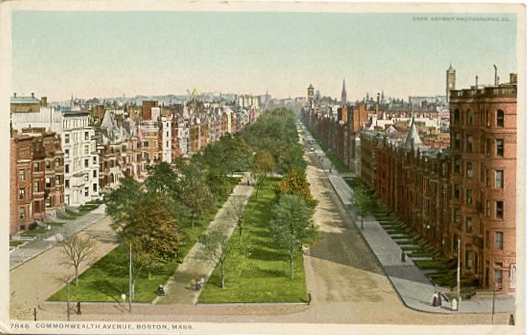







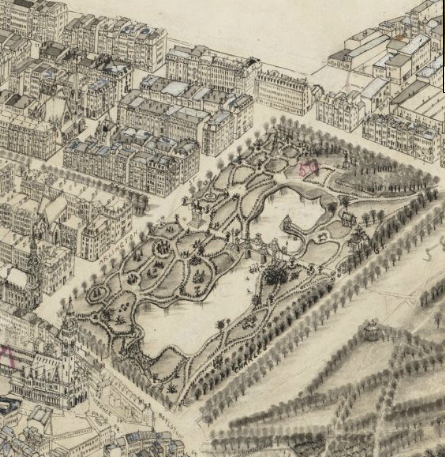

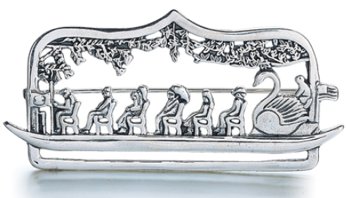






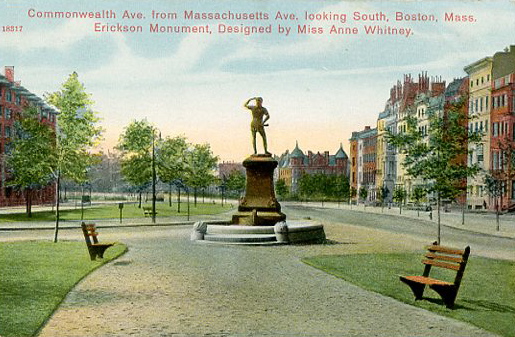

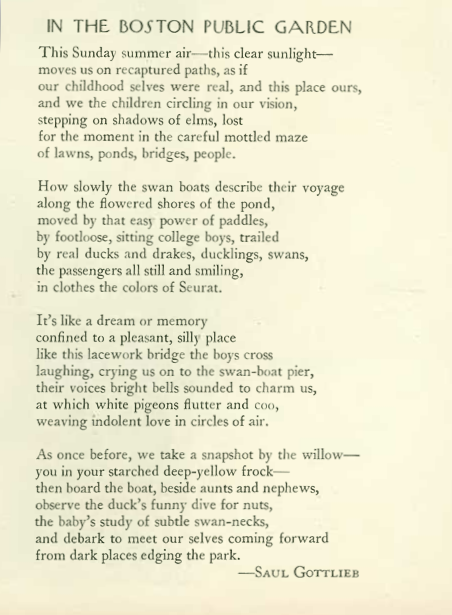












This is a lovely article and I also ask, ” Is the new Boston’s public realm going to be as imageable (and walkable) as the old? Will it be of its time while standing the test of time?”
South Boston is exploding with constuction, which is fabulous for our economy; however I wonder if it is going to relate to the exisiting in a ‘walkable’ way. Scale, shadow, views, activated store fronts, materials, connectivity, access, and greenspace are what create place.
I trust that our planners, landscape architects, architects, and engineers will protect this great city as we develop a 21st century transportation system and innovative waterfront community.
Kristine,
Thanks for your comment. This is an important opportunity for the “new” Boston and one that needs to be sensitively and creatively managed and designed.
Thank you for the tour of this impressive public space! The poem seems to catch the mood wonderfully and, as well as conjuring a sense of the past, has something to say to the present. All very interesting. Warm wishes, Linda
Good post! Love the South Boson Waterfront dig! 🙂
Sent from my iPhone
Patrice, I just recently discovered your blog in the new listings at Blotanical and am enjoying it very much (especially since I grew up south of Boston and still visit that city fairly often). I do a regular “garden blogs of the month” feature on my blog, Jean’s Garden, where I review and recommend garden blogs that I think my readers would enjoy. Your blog is one of three that I am highlighting this month. My post reviewing your blog just went up, and your blog will be featured on my sidebar throughout the month.
Patrice – I found your blog through Jean, and I am so glad I found you, and especially this wonderful post. My son lives in Cambridge and we are are visiting him in a couple of weeks with the specific task of looking around Boston and environs with the possibility in mind of moving to environs, if not Boston itself. Not the best time of year for garden walking, but still. . . . As a garden writer who has a personal interest in one public garden I hope you will visit is the Bridge of Flowers in Shelburne Falls, Mass. Our website is in the process of being redesigned but you can visit my commonweeder.com blog at this link http://tinyurl.com/79xce6u and get some idea. I have several postings about the Bridge which some have called the original High Line. Of course the High Line (which I have visited) has fewer flowers but is is a LOT bigger. I will be visiting here regularly!
Thanks! I haven’t seen the Bridge of Flowers for many years. You may know that The Boston Harbor Association in partnership with landscape architect David Warner is planning to add landscape elements (I think mainly flowers) to the Northern Avenue Bridge creating Boston’s own “Bridge of Flowers.”